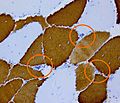Myotonic dystrophy facts for kids
Myotonic dystrophy is a genetic condition that mainly affects your muscles. It's like your muscles don't relax properly after you use them, and they can also get weaker over time. This condition is passed down through families. There are two main types, called type 1 (DM1) and type 2 (DM2), and they are caused by tiny changes in different genes. Specifically, DM1 is linked to a gene called DMPK, and DM2 is linked to the CNBP gene. Currently, there is no cure for myotonic dystrophy, but doctors and scientists are always working to find new ways to help people who have it.
Contents
What is Myotonic Dystrophy?
Myotonic dystrophy is a condition that you are born with, even if symptoms don't show up until later in life. It's caused by a mistake in your DNA, which is like the instruction manual for your body. This mistake affects how your muscles work, making them stiff or slow to relax after they contract. Imagine trying to let go of a doorknob, but your hand stays clenched for a few seconds – that's a bit like what myotonia feels like. Over time, muscles can also become weaker and waste away.
How Does it Affect Muscles?
The main problem in myotonic dystrophy is called myotonia. This means your muscles have trouble relaxing after they've been used. For example, if you make a tight fist, it might take a moment or two for your hand to open fully. This can affect many muscles, including those in your hands, arms, legs, and even your face.
Besides myotonia, people with this condition often experience muscle weakness. This weakness can get worse over time and might affect daily activities like walking, climbing stairs, or lifting things. It can also make muscles feel stiff or achy.
Beyond Muscles: Other Body Systems
Myotonic dystrophy doesn't just affect muscles. It can also impact other parts of the body because the faulty gene is present in many different cells. Some common effects include:
- Eyes: Many people develop cataracts, which are cloudy areas in the lens of the eye that can make vision blurry.
- Heart: The heart is a muscle, so it can be affected too. This might lead to problems with the heart's rhythm or how well it pumps blood.
- Brain: Some people might experience changes in thinking, learning, or memory. They might also feel very tired or sleepy during the day.
- Digestion: Muscles in the digestive system can be affected, leading to problems like difficulty swallowing or stomach issues.
- Hormones: The condition can sometimes affect glands that produce hormones, like the thyroid or pancreas.
Types of Myotonic Dystrophy
There are two main types of myotonic dystrophy, and they are caused by changes in different genes. Both types are passed down in a similar way, meaning if one parent has the condition, there's a chance their child will too.
Type 1 (DM1)
Type 1 myotonic dystrophy, often called Steinert's disease, is the most common form. It's caused by a change in the DMPK gene. The symptoms of DM1 can vary a lot, even within the same family.
- Congenital DM1: This is the most severe form and starts at birth. Babies might have serious breathing problems, muscle weakness, and feeding difficulties.
- Childhood DM1: Symptoms appear in childhood, often including learning difficulties, speech problems, and muscle weakness.
- Adult DM1: This is the most common form of DM1. Symptoms usually start in the teenage years or adulthood. They include muscle stiffness, weakness, and problems with other body systems like the heart or eyes.
Type 2 (DM2)
Type 2 myotonic dystrophy is less common than DM1 and is caused by a change in the CNBP gene. The symptoms of DM2 are often milder than DM1 and usually start in adulthood.
- Main Symptoms: People with DM2 often experience muscle pain, stiffness, and weakness, especially in the neck, shoulders, and hips.
- Other Effects: Like DM1, it can also affect the heart, eyes (cataracts are common), and sometimes cause tiredness. However, the effects on other body systems are generally less severe than in DM1.
How is Myotonic Dystrophy Diagnosed?
Doctors usually suspect myotonic dystrophy based on a person's symptoms and a physical exam. They might notice the characteristic muscle stiffness or weakness. To confirm the diagnosis, a special blood test called a genetic test is done. This test looks for the specific changes in the DMPK or CNBP genes that cause the condition. Sometimes, a doctor might also do a muscle biopsy (taking a tiny sample of muscle tissue) or an electromyography (EMG) test, which checks how well nerves and muscles are working.
Living with Myotonic Dystrophy
While there is no cure for myotonic dystrophy, there are many ways to manage the symptoms and help people live full lives.
- Physical Therapy: This can help improve muscle strength, flexibility, and balance. Therapists can teach exercises and stretches to keep muscles working as well as possible.
- Occupational Therapy: This helps people find ways to do daily tasks more easily, even with muscle weakness or stiffness. They might suggest special tools or different ways to do things.
- Speech Therapy: If the muscles for speaking or swallowing are affected, a speech therapist can help.
- Medications: Doctors might prescribe medicines to help with specific symptoms, such as muscle stiffness or pain.
- Regular Check-ups: Because myotonic dystrophy can affect different parts of the body, regular visits to specialists like heart doctors (cardiologists) or eye doctors (ophthalmologists) are important to monitor for any issues.
Living with myotonic dystrophy means learning to adapt and use strategies to manage the challenges. Support groups and patient organizations can also be a great resource for families.
Images for kids
See also
 In Spanish: Distrofia miotónica de Steinert para niños
In Spanish: Distrofia miotónica de Steinert para niños


